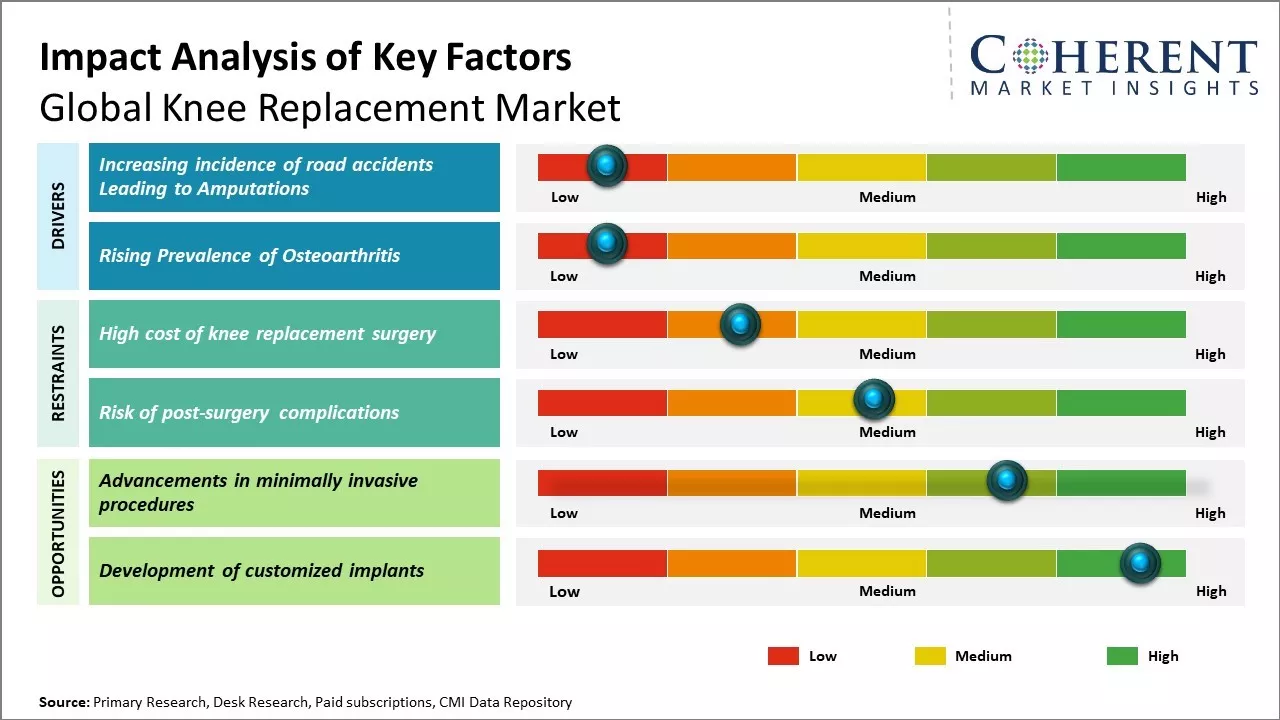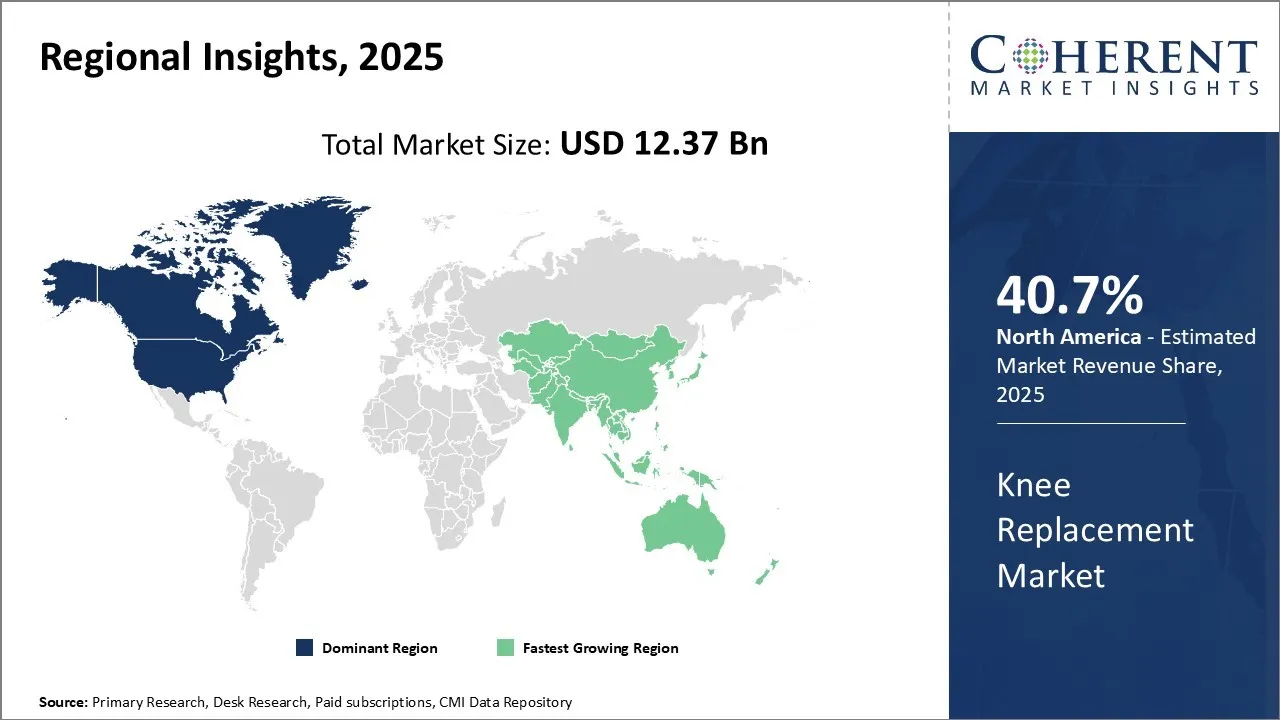The knee replacement market is estimated to be valued at USD 12.37 Bn in 2025 and is expected to reach USD 17.18 Bn by 2032, exhibiting a compound annual growth rate (CAGR) of 4.8% from 2025 to 2032.

To learn more about this report, Download Free Sample
Global knee replacement market is expected to witness significant growth over the forecast period, due to rising geriatric population worldwide and increasing number of osteoarthritis and rheumatoid arthritis cases. Increasing sport injuries and road accidents that damage the knee ligaments can boost the demand for knee replacement surgeries. Furthermore, rapid innovation in technologies and development of advanced implants and instrumentation for replacement surgeries are making them safer and more effective.
However, high cost of knee replacement surgeries and prolonged recovery time post-surgery can hamper the market growth.

To learn more about this report, Download Free Sample
|
Current Events |
Description and its impact |
|
Regulatory Policy Shifts |
|
|
Geopolitical and Economic Pressures |
|
Uncover macros and micros vetted on 75+ parameters: Get instant access to report
Increasing number of road accidents across the globe can drive the global knee replacement market growth. Knee injuries are one of the most common injuries suffered in road accidents involving vehicles. Severe knee injuries often lead to long term impairment and disability, which can only be treated by knee replacement surgeries.
Rising prevalence of osteoarthritis, the most common cause of knee replacements, can drive the market growth. Osteoarthritis occurs when the protective cartilage that cushions the ends of bones wears down over time. This causes friction and irritation in the joint. The knee is one of the weight-bearing joints that bears the brunt of osteoarthritis due to factors like increased life expectancy, obesity, and physical inactivity among older populations.
For instance, according to the World Health Organization (July 2023), osteoarthritis affects approximately 365 million people globally in the knee. This makes it the most frequently impacted joint followed by the hip and hand. Additionally, 344 million individuals with osteoarthritis experience moderate to severe symptoms that could benefit from rehabilitation interventions.
In terms of procedure, total knee replacement segment is estimated to contribute the highest market share of 60.6% in 2025, owing to the increasing demand for joint replacement surgeries among aging populations globally.
Total knee replacement procedures help alleviate chronic joint pain and restore mobility in patients suffering from severe osteoarthritis or other degenerative conditions of the knee joint. As life expectancy rises worldwide, there has been an increase in the number of elderly individuals experiencing joint disorders. This rising geriatric demographic boosts demand.
In terms of implant type, mobile-bearing implants segment is estimated to contribute the highest market share of 50.12% in 2025. Mobile implants allow more natural knee movement by maintaining flexibility in the insert that acts as a cushion between the femoral component and tibial component.
The key advantage of mobile-bearing implants over fixed implants is lower risk of implant loosening over time as these experience less shear stress at the bone-implant interfaces. Furthermore, material advancements have made these implants more durable and comfortable for patients. Manufacturers continue innovating new polymer and alloy formulations that mimic natural joint properties more closely.
In terms of material, the ceramic-on-ceramic segment is estimated to contribute the highest market share of 49.13% in 2025, due to biocompatibility and wear resistance advantages of ceramic components.
Ceramic bearings have very low friction coefficients minimizing wear particulate release which often leads to osteolysis in other material combinations over the long term. Since ceramic is very stable and durable, ceramic-on-ceramic implants undergo negligible wear even after 10-15 years post-surgery. Absence of corrosion or allergic reactions with ceramic further elevates its biocompatibility.
Application: Using real-time imaging and computer guidance, surgeons now can plan and perform total knee replacement surgery with greater precision, tailored to your exact knee anatomy. This helps ensure better alignment and implant positioning, potentially improving longer-lasting results.
Example: In June 2024, Jhansi Orthopaedic Hospital announced the launch of revolutionary medical technology. This meticulous mapping allows for optimal placement of the knee implant, significantly reducing the potential for human error.
Application: These high-tech implants are equipped with tiny sensors that track the performance of the new knee joint. Healthcare providers can monitor recovery remotely, adjust rehabilitation plans as necessary, and detect potential issues early. This results in fewer in-person follow-up visits and more personalized recovery care.
Example: The Persona IQ Smart Knee implant represents a significant advancement in orthopedic innovation. It integrates the personalized fit of the Persona Knee system with a smart stem extension equipped with sensors that continuously collect motion data following knee replacement surgery.
Knee replacement management in clinical trials is being revolutionized by AI-powered solutions

To learn more about this report, Download Free Sample
North America is the dominant region in the global knee replacement market with an estimated market share of 40.7% in 2025. The large size of the market in the U.S., along with strong healthcare infrastructure and high healthcare spending has made North America the premier location for major knee replacement device manufacturers. Several leading global players like Zimmer Biomet, Stryker Corporation and Johnson & Johnson have sizable operations and manufacturing facilities located in the U.S., catering to the local as well as international demand.
For instance, in March 2025, at AAOS in San Diego, Zimmer Biomet showcased a comprehensive portfolio of orthopedic and musculoskeletal innovations. The company highlighted its Z1 Triple‑Taper hip system, introduced newly launched knee and upper-extremity reconstructive technologies including the FDA-cleared Persona Revision SoluTion Femur and unveiled its ZBX Ambulatory Surgery Center solutions to support expanded outpatient capabilities.
The Asia Pacific region has emerged as the fastest growing market for knee replacements globally in the recent years. In particular, countries like China, Japan and India have witnessed double digit growth, and are gradually catching up to developed markets. This can be attributed to growing awareness about treatment options and rising affordability of implants and surgeries.
For instance, in February 2025, Singapore's Alexandra Hospital developed world's first A.I. algorithm for robotic knee replacements. As the world's first computational algorithm for robotic total knee replacement (rTKR), the new AI algorithm is granted an international Patent Cooperation Treaty (PCT) patent.
The presence of major orthopedic surgical centers and growing geriatric population suffering from osteoarthritis has boosted the number of knee replacement surgeries in the U.S. The pricing of knee implants is also regulated by government bodies, thus, ensuring affordability for patients.
For instance, in November 2024, Zimmer Biomet received Food and Drug Administration approval for Oxford Cementless Partial Knee, Only Cementless Partial Knee Replacement Implant in the U.S.
India's market is still untapped and holds huge future potential. Growing medical tourism where patients travel to India from other Asian and African countries for affordable surgeries has further boosted the knee replacement volumes in the country.
For instance, according to data released by the credit rating agency Crisil, the number of medical tourists visiting India is projected to reach approximately 7.3 million in 2024, up from an estimated 6.1 million in 2023. World-class amenities, a pool of skilled and well-trained medical experts and cost-effective treatment alternatives make India an appealing destination for those seeking high-quality healthcare services. India has become a popular choice for ‘medical value travel’ in recent times.
Germany serves as the largest market for knee replacements in Europe, fueled by a strong orthopedic infrastructure and a well-established public healthcare system. A significant portion of the elderly population requires joint replacements, while national initiatives to reduce surgical waiting times have accelerated procedural volumes. Additionally, Germany’s emphasis on digital health integration is boosting the adoption of AI-powered navigation systems and smart implants, enhancing procedural outcomes and postoperative care.
In Brazil, expanding private healthcare infrastructure, rising geriatric demographics, and increasing awareness about orthopedic care propel market growth. Urban populations are increasingly seeking joint replacement procedures, while public-private collaborations are improving access to advanced implants. The country is also seeing growing interest in minimally invasive techniques and robotic-assisted knee replacements, particularly in private hospitals in São Paulo and Rio de Janeiro.
| Report Coverage | Details | ||
|---|---|---|---|
| Base Year: | 2024 | Market Size in 2025: | USD 12.37 Bn |
| Historical Data for: | 2020 To 2024 | Forecast Period: | 2025 To 2032 |
| Forecast Period 2025 to 2032 CAGR: | 4.8% | 2032 Value Projection: | USD 17.18 Bn |
| Geographies covered: |
|
||
| Segments covered: |
|
||
| Companies covered: |
Zimmer Biomet Holdings, Inc., Stryker Corporation, DePuy Synthes (a Johnson & Johnson company), Smith & Nephew plc, B. Braun Melsungen AG, Medtronic plc, Conformis Inc., MicroPort Scientific Corporation, DJO Global, Inc., Exactech Inc., Corin Group, Waldemar LINK GmbH & Co. KG, Arthrex Inc., Kinamed Incorporated, Bioimpianti, Ortho Development Corporation, THINK Surgical, Inc., and OMNIlife science Inc. |
||
| Growth Drivers: |
|
||
| Restraints & Challenges: |
|
||
Uncover macros and micros vetted on 75+ parameters: Get instant access to report
*Definition: The knee replacement market refers to the global industry focused on the development, manufacturing, and distribution of knee implants, surgical instruments, and related technologies used in knee arthroplasty procedures. These procedures involve the partial or total replacement of damaged or diseased knee joints with artificial components to relieve pain and restore mobility, primarily in patients with osteoarthritis, rheumatoid arthritis, or knee injuries. The market encompasses total knee replacement (TKR), partial knee replacement (PKR), revision surgeries, and increasingly, robot-assisted and AI-integrated systems that enhance surgical precision and patient outcomes.
Share
Share
About Author
Manisha Vibhute is a consultant with over 5 years of experience in market research and consulting. With a strong understanding of market dynamics, Manisha assists clients in developing effective market access strategies. She helps medical device companies navigate pricing, reimbursement, and regulatory pathways to ensure successful product launches.
Missing comfort of reading report in your local language? Find your preferred language :
Transform your Strategy with Exclusive Trending Reports :
Frequently Asked Questions
Joining thousands of companies around the world committed to making the Excellent Business Solutions.
View All Our Clients